Subaru Forester: Warning and indicator lights
Several of the warning and indicator lights illuminate momentarily and then turn off when the ignition switch is initially turned to the “ON” position. This permits checking the operation of the bulbs.
Apply the parking brake and turn the ignition switch to the “ON” position. For the system check, the following lights illuminate and turn off after several seconds or after the engine has started.

Seatbelt warning light
(The seatbelt warning light turns off only when the driver fastens the seatbelt.)

Front passenger’s seatbelt warning light
(The seatbelt warning light turns off only when the front seat passenger fastens the seatbelt.)

SRS airbag system warning light

Front passenger’s frontal airbag ON indicator light

Front passenger’s frontal airbag OFF indicator light

CHECK ENGINE warning light/Malfunction indicator lamp

Coolant temperature high warning light (if equipped)

Charge warning light

Oil pressure warning light

AT OIL TEMP warning light AT models)

Low tire pressure warning light (U.S.- spec. models)

ABS warning light

Brake system warning light

Low fuel warning light

Hill start assist warning light (MT models)

Door open warning light

AWD warning light (AT models)

Vehicle Dynamics Control warning light/Vehicle Dynamics Control operation indicator light

Vehicle Dynamics Control OFF indicator light

SPORT mode indicator light (AT models)

Cruise control indicator light

Cruise control set indicator light

Automatic headlight beam leveler warning light (models with HID headlights)
If any lights fail to illuminate, it indicates a burned-out bulb or a malfunction of the corresponding system.
Consult your authorized SUBARU dealer for repair.
Seatbelt warning light and chime

Your vehicle is equipped with a seatbelt warning device at the driver’s and front passenger’s seat, as required by current safety standards.
With the ignition switch turned to the “ON” position, this device reminds the driver and front passenger to fasten their seatbelts by illuminating the warning lights in the locations indicated in the following illustration and sounding a chime.
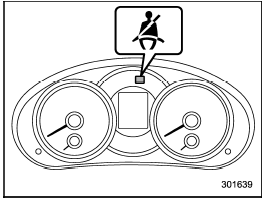
Driver’s warning light (type A)
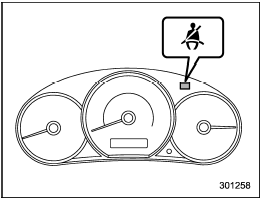
Driver’s warning light (type B)
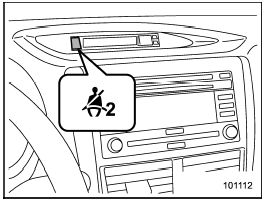
Front passenger’s warning light
Operation
If the driver and/or front passenger have/ has not yet fastened the seatbelt(s) when the ignition switch is turned to the “ON” position, the seatbelt warning light(s) will flash for 6 seconds, to warn that the seatbelt(s) is/are unfastened. If the driver’s seatbelt is not fastened, a chime will also sound simultaneously.
NOTE
- If the driver’s and/or front passenger’s
seatbelt(s) are/is still not fastened
6 seconds later, the seatbelt warning
device operates as follows according
to the vehicle speed.
– At speeds lower than approximately
9 mph (15 km/h)
The warning light(s) for unfastened
seatbelt(s) will alternate between
steady illumination and flashing at
15-second intervals. The chime will
not sound.
– At speeds higher than approximately
9 mph (15 km/h)
The warning light(s) for unfastened
seatbelt(s) will alternate between
flashing and steady illumination at
15-second intervals and the chime
will sound while the warning light(s)
is/are flashing.
If there is no passenger on the front passenger’s seat, the seatbelt warning device for the front passenger’s seat will be deactivated. The front passenger’s occupant detection system monitors whether or not there is a passenger on the front passenger’s seat.
Observe the following precautions. Failure to do so may prevent the device from functioning correctly or cause the device to fail.
- Do not install any accessory such as a table or TV onto the seatback.
- Do not store a heavy load in the seatback pocket.
- Do not allow the rear seat occupant to place his/her hands or legs on the front passenger’s seatback, or allow him/her to pull the seatback.
- Do not use front seats with their backward- forward position and seatback not being locked into place securely. If any of them are not locked securely, adjust them again. For the adjustment procedure of the manual seats, refer to “Manual seat”.
If the seatbelt warning device for the front passenger’s seat does not function correctly (e.g., it is activated even when the front passenger’s seat is empty or it is deactivated even when the front passenger has not fastened his/her seatbelt), take the following actions.
- Ensure that no article is placed on the seat other than a child restraint system and its child occupant, although we strongly recommend that all children sit in the rear seat properly restrained.
- Ensure that there is no article left in the seatback pocket.
- Ensure that the backward-forward position and seatback of front passenger’s seat are locked into place securely by moving the seat back and forth.
If still the seatbelt warning device for front passenger’s seat does not function correctly after taking relevant corrective actions described above, immediately contact your SUBARU dealer for an inspec- tion.
SRS airbag system warning light


If the warning light exhibits any of the following conditions, there may be a malfunction in the seatbelt pretensioners and/or SRS airbag system. Immediately take your vehicle to your nearest SUBARU dealer to have the system checked. Unless checked and properly repaired, the seatbelt pretensioners and/or SRS airbag will not operate properly in the event of a collision, which may increase the risk of injury.
- Flashing or flickering of the warning
light
- No illumination of the warning
light when the ignition switch is
first turned to the “ON” position
- Continuous illumination of the
warning light
- Illumination of the warning light
while driving
Front passenger’s frontal airbag ON and OFF indicators
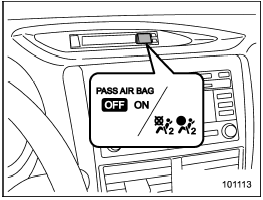
Front passenger’s frontal airbag ON and OFF indicators
 Front passenger’s frontal airbag
ON indicator
Front passenger’s frontal airbag
ON indicator
 Front passenger’s frontal airbag
OFF indicator
Front passenger’s frontal airbag
OFF indicator
The front passenger’s frontal airbag ON and OFF indicators show you the status of the front passenger’s SRS frontal airbag.
The indicators are located next to the clock in the center portion of the dashboard.
When the ignition switch is turned to the “ON” position, both the ON and OFF indicators illuminate for 6 seconds during which time the system is checked. Following the system check, both indicators turn off for 2 seconds. After that, one of the indicators illuminates depending on the status of the front passenger’s SRS frontal airbag determined by the SUBARU advanced frontal airbag system monitoring.
If the front passenger’s SRS frontal airbag is activated, the passenger’s frontal airbag ON indicator will illuminate while the OFF indicator will remain off.
If the front passenger’s SRS frontal airbag is deactivated, the passenger’s frontal airbag ON indicator will remain off while the OFF indicator will illuminate.
With the ignition switch turned to the “ON” position, if both the ON and OFF indicators remain illuminated or off simultaneously even after the system check period, the system is malfunctioning.
Contact your SUBARU dealer immediately for an inspection.
CHECK ENGINE warning light/Malfunction indicator lamp


If the CHECK ENGINE light illuminates while you are driving, have your vehicle checked/repaired by your SUBARU dealer as soon as possible. Continued vehicle operation without having the emission control system checked and repaired as necessary could cause serious damage, which may not be covered by your vehicle’s warranty.
If this light illuminates steadily or blinks while the engine is running, it may indicate that there is a problem or potential problem somewhere in the emission control system.
If the light illuminates steadily
If the light illuminates steadily while driving or does not turn off after the engine starts, an emission control system malfunction has been detected.
You should have your vehicle checked by an authorized SUBARU dealer immediately.
NOTE
This light also illuminates when the fuel
filler cap is not tightened until it clicks.
If you have recently refueled your vehicle, the cause of the CHECK ENGINE warning light/malfunction indicator lamp coming on could be a loose or missing fuel filler cap.
Remove the cap and retighten it until it clicks. Make sure nothing is interfering with the sealing of the cap. Tightening the cap will not make the CHECK ENGINE warning light turn off immediately. It may take several driving trips. If the light does not turn off, take your vehicle to your authorized SUBARU dealer immediately.
If the light is blinking
If the light is blinking while driving, an engine misfire condition has been detected which may damage the emission control system.
To prevent serious damage to the emission control system, you should do the following.
- Reduce vehicle speed.
- Avoid hard acceleration.
- Avoid steep uphill grades.
- Reduce the amount of cargo, if possible.
The CHECK ENGINE warning light may stop blinking and illuminate steadily after several driving trips. You should have your vehicle checked by an authorized SUBARU dealer immediately.
Coolant temperature low indicator light (if equipped)/Coolant temperature high warning light (if equipped)


- After turning the ignition switch to the “ON” position, if this indicator light/warning light behaves under any of the following conditions, the electrical system may be malfunctioning. Contact your SUBARU dealer immediately for an inspection.
– It remains blinking in RED.
– It remains illuminated in RED for more than 2 seconds.
– It remains blinking in RED and BLUE alternately.
- While driving, if this indicator light/warning light behaves under any of the following conditions, take the specified appropriate measure listed below.
– Blinking or illuminated in
RED:
Safely stop the vehicle as
soon as possible, and refer
to the emergency steps for the
engine overheating. Afterward,
have the system
checked by your nearest
SUBARU dealer. Refer to “Engine
overheating”.
– Blinking in RED and BLUE
alternately:
The electrical system may be
malfunctioning. Contact your
SUBARU dealer for an inspection.
This coolant temperature low indicator light/coolant temperature high warning light has the following three functions.
- Illumination in BLUE indicates insufficient
warming up of the engine
- Blinking in RED indicates that the
engine is close to overheating
- Illumination in RED indicates overheating
condition of the engine
For the system check, this indicator light/ warning light illuminates in RED for approximately 2 seconds when the ignition switch is turned to the “ON” position.
After that, this indicator light/warning light changes to BLUE and maintains illumination in BLUE. This BLUE illuminated light turns off when the engine is warmed up sufficiently.
If the engine coolant temperature increases over the specified range, the indicator light/warning light blinks in RED. At this time, the engine is close to overheating.
If the engine coolant temperature increases further, the indicator light/warning light illuminates in RED continuously. At this time, the engine may be overheating.
When the indicator light/warning light blinks in RED or illuminates in RED, safely stop the vehicle as soon as possible, and refer to the emergency steps for the engine overheating. Refer to “Engine overheating”. Afterward, have the system checked by your nearest SUBARU dealer.
Also, if the indicator light/warning light often blinks in RED, the electrical system may be malfunctioning. Contact your SUBARU dealer for an inspection.
NOTE
If the engine is restarted after a certain
driving condition, this indicator light/
warning light may illuminate in RED.
However, this is not a malfunction if the indicator light/warning light turns off after a short time.
Charge warning light

If this light illuminates when the engine is running, it may indicate that the charging system is not working properly.
If the light illuminates while driving or does not turn off after the engine starts, stop the engine at the first safe opportunity and check the alternator belt. If the belt is loose, broken or if the belt is in good condition but the light remains on, contact your nearest SUBARU dealer immediately.
Oil pressure warning light

If this light illuminates when the engine is running, it may indicate that the engine oil pressure is low and the lubricating system is not working properly.
If the light illuminates while driving or does not turn off after the engine starts, stop the engine at the first safe opportunity and check the engine oil level. If the oil level is low, add oil immediately. If the engine oil is at the proper level but the light remains on, contact your nearest SUBARU dealer immediately.

Do not operate the engine with the oil pressure warning light on. This may cause serious engine damage.
AT OIL TEMP warning light (AT models)

If this light illuminates when the engine is running, it may indicate that the automatic transmission fluid temperature is too hot.
If the light illuminates while driving, immediately stop the vehicle in a safe place and let the engine idle until the warning light turns off.
Automatic transmission control system warning
If the light flashes after the engine starts, it may indicate that the automatic transmission control system is not working properly.
Contact your nearest SUBARU dealer for service immediately.
Low tire pressure warning light (U.S.-spec. models)

When the ignition switch is turned to the “ON” position, the low tire pressure warning light will illuminate for approximately 2 seconds to check that the tire pressure monitoring system (TPMS) is functioning properly. If there is no problem and all tires are properly inflated, the light will turn off.
Each tire, including the spare (if provided), should be checked monthly when cold and inflated to the inflation pressure recommended by the vehicle manufacturer on the vehicle placard or tire inflation pressure label. (If your vehicle has tires of a different size than the size indicated on the vehicle placard or tire inflation pressure label, you should determine the proper tire inflation pressure for those tires.) As an added safety feature, your vehicle has been equipped with a tire pressure monitoring system (TPMS) that illuminates a low tire pressure telltale when one or more of your tires is significantly underinflated.
Accordingly, when the low tire pressure telltale illuminates, you should stop and check your tires as soon as possible, and inflate them to the proper pressure. Driving on a significantly underinflated tire causes the tire to overheat and can lead to tire failure. Under-inflation also reduces fuel efficiency and tire tread life, and may affect the vehicle’s handling and stopping ability.
Please note that the TPMS is not a substitute for proper tire maintenance, and it is the driver’s responsibility to maintain correct tire pressure, even if under-inflation has not reached the level to trigger illumination of the TPMS low tire pressure telltale.
Your vehicle has also been equipped with a TPMS malfunction indicator to indicate when the system is not operating properly.
The TPMS malfunction indicator is combined with the low tire pressure telltale.
When the system detects a malfunction, the telltale will flash for approximately one minute and then remain continuously illuminated. This sequence will continue upon subsequent vehicle start-ups as long as the malfunction exists. When the malfunction indicator is illuminated, the system may not be able to detect or signal low tire pressure as intended. TPMS malfunctions may occur for a variety of reasons, including the installation of replacement or alternate tires or wheels on the vehicle that prevent the TPMS from functioning properly. Always check the TPMS malfunction telltale after replacing one or more tires or wheels on your vehicle to ensure that the replacement or alternate tires and wheels allow the TPMS to continue to function properly.
Should the warning light illuminate steadily after blinking for approximately one minute, have the system inspected by your nearest SUBARU dealer as soon as possible.

If this light does not illuminate briefly after the ignition switch is turned ON or the light illuminates steadily after blinking for approximately one minute, you should have your Tire Pressure Monitoring System checked at a SUBARU dealer as soon as possible.
If this light illuminates while driving, never brake suddenly and keep driving straight ahead while gradually reducing speed. Then slowly pull off the road to a safe place.
Otherwise an accident involving serious vehicle damage and serious personal injury could occur.
If this light still illuminates while driving after adjusting the tire pressure, a tire may have significant damage and a fast leak that causes the tire to lose air rapidly. If you have a flat tire, replace it with a spare tire as soon as possible.
When a spare tire is mounted or a wheel rim is replaced without the original pressure sensor/transmitter being transferred, the Low tire pressure warning light will illuminate steadily after blinking for approximately one minute. This indicates the TPMS is unable to monitor all four road wheels. Contact your SUBARU dealer as soon as possible for tire and sensor replacement and/ or system resetting. If the light illuminates steadily after blinking for approximately one minute, promptly contact a SUBARU dealer to have the system inspected.

The tire pressure monitoring system is NOT a substitute for manually checking tire pressure. The tire pressure should be checked periodically (at least monthly) using a tire gauge. After any change to tire pressure(s), the tire pressure monitoring system will not re-check tire inflation pressures until the vehicle is first driven more than 20 mph (32 km/h). After adjusting the tire pressures, increase the vehicle speed to at least 20 mph (32 km/h) to start the TPMS re-checking of the tire inflation pressures. If the tire pressures are now above the severe low pressure threshold, the low tire pressure warning light should turn off a few minutes later. Therefore, be sure to install the specified size for the front and rear tires.
ABS warning light


- If any of the following conditions occur, we recommend that you have the ABS system repaired at the first available opportunity by your SUBARU dealer.
– The warning light does not illuminate when the ignition switch is turned to the “ON” position.
– The warning light illuminates when the ignition switch is turned to the “ON” position, but it does not turn off even when the vehicle speed exceeds approximately 8 mph (12 km/h).
– The warning light illuminates during driving.
- When the warning light is on (and the brake system warning light is off), the ABS function shuts down. However, the conventional brake system continues to operate normally.
With a vehicle equipped with an EBD system, the ABS warning light illuminates together with the brake system warning light if the EBD system malfunctions. For further details of the EBD system malfunction warning, refer to “Brake system warning light”.
NOTE
If the warning light behavior is as
described in the following items, the
ABS system may be considered normal.
- The warning light illuminates right after the engine is started but turns off immediately, remaining off.
- The warning light remains on after the engine has been started, but it turns off when the vehicle speed reaches approximately 8 mph (12 km/h).
- The warning light illuminates during driving, but it turns off immediately and remains off.
When driving with an insufficient battery voltage such as when the engine is jump started, the ABS warning light may illuminate.
This is due to the low battery voltage and does not indicate a malfunction.
When the battery becomes fully charged, the light will turn off.
Brake system warning light


- Driving with the brake system warning light on is dangerous.
This indicates your brake system may not be working properly. If the light remains illuminated, have the brakes inspected by a SUBARU dealer immediately.
- If at all in doubt about whether the brakes are operating properly, do not drive the vehicle.
Have your vehicle towed to the nearest SUBARU dealer for repair.
This light has the following functions.
Parking brake warning
The light illuminates with the parking brake applied while the ignition switch is in the “ON” position. It turns off when the parking brake is fully released.
Brake fluid level warning
This light illuminates when the brake fluid level has dropped to near the “MIN” level of the brake fluid reservoir with the ignition switch in the “ON” position and with the parking brake fully released.
If the brake system warning light should illuminate while driving (with the parking brake fully released and with the ignition switch positioned in “ON”), it could be an indication of leaking of brake fluid or worn brake pads. If this occurs, immediately stop the vehicle at the nearest safe place and check the brake fluid level. If the fluid level is below the “MIN” mark in the reservoir, do not drive the vehicle. Have the vehicle towed to the nearest SUBARU dealer for repair.
Electronic Brake Force Distribution (EBD) system warning
The brake system warning light also illuminates if a malfunction occurs in the EBD system. In that event, it illuminates together with the ABS warning light.
The EBD system may be malfunctioning if the brake system warning light and ABS warning light illuminate simultaneously during driving.
Even if the EBD system fails, the conventional braking system will still function.
However, the rear wheels will be more prone to locking when the brakes are applied harder than usual and the vehicle’s motion may therefore become somewhat harder to control.
If the brake system warning light and ABS warning light illuminate simultaneously, take the following steps.
1. Stop the vehicle in the nearest safe, flat place.
2. Shut down the engine, apply the parking brake and then restart it.
3. Release the parking brake. If both warning lights turn off, the EBD system may be malfunctioning. Drive carefully to the nearest SUBARU dealer and have the system inspected.
4. If both warning lights illuminate again and stay illuminated after the engine has been restarted, shut down the engine again, apply the parking brake, and check the brake fluid level.
5. If the brake fluid level is not below the “MIN” mark, the EBD system may be malfunctioning. Drive carefully to the nearest SUBARU dealer and have the system inspected.
6. If the brake fluid level is below the “MIN” mark, DO NOT drive the vehicle.
Instead, have the vehicle towed to the nearest SUBARU dealer for repair.
Low fuel warning light

The low fuel warning light illuminates when the tank is nearly empty approximately 2.6 US gal (10.0 liters, or 2.2 Imp gal). It only operates when the ignition switch is in the “ON” position. When this light illuminates, fill the fuel tank immediately.
NOTE
This light does not turn off unless the
tank is replenished up to an internal
fuel quantity of approximately 3.7 US
gal (14 liters, 3.1 Imp gal).

Promptly put fuel in the tank whenever the low fuel warning light illuminates. Engine misfires as a result of an empty tank could cause damage to the engine.
Hill start assist warning light (MT models)

While the engine is rotating, if there are any malfunctions in the Hill start assist system, the light will illuminate.

When the Hill start assist warning light illuminates, have the vehicle inspected at an authorized SUBARU dealer.
Door open warning light

The door open warning light illuminates if any door or the rear gate is not fully closed.
Always make sure this light is out before you start to drive.
All-Wheel Drive warning light (AT models)

This light illuminates when All-Wheel Drive is disengaged and the drive mechanism is switched to Front Wheel Drive for maintenance or similar purposes.
It flashes if the vehicle is driven with tires of differing diameters fitted on the wheels or with an excessively low air pressure in any of the tires.

Continuing to drive with the AWD warning light flashing can damage the powertrain. If the AWD warning light starts to flash, promptly park in a safe place and check whether the tires have differing diameters and whether any of the tires has an excessively low inflation pressure.
Automatic headlight beam leveler warning light (models with HID headlights)

This light illuminates when the automatic headlight beam leveler does not operate normally.
If this light illuminates while driving or does not turn off approximately 3 seconds after turning the ignition switch to the “ON” position, have your vehicle inspected at your SUBARU dealer.
Vehicle Dynamics Control warning light/ Vehicle Dynamics Control operation indicator light

Vehicle Dynamics Control warning light

The Vehicle Dynamics Control system provides its ABS control through the electrical circuit of the ABS system. Accordingly, if the ABS is inoperative, the Vehicle Dynamics Control system becomes unable to provide ABS control. As a result, the Vehicle Dynamics Control system also becomes inoperative, causing the warning light to illuminate.
Though both the Vehicle Dynamics Control and ABS systems are inoperative in this case, the ordinary functions of the brake system are still available. You will be safe while driving with this condition, but drive carefully and have your vehicle checked at a SUBARU dealer as soon as possible.
NOTE
- If the electrical circuit of the Vehicle
Dynamics Control system itself malfunctions,
only this particular warning
light illuminates. Under these circumstances,
the ABS (Anti-lock Brake
System) remains fully operational.
- The warning light illuminates when the electronic control system of the ABS/Vehicle Dynamics Control system malfunctions.
The Vehicle Dynamics Control system is probably inoperative under any of the following conditions. Have your vehicle checked at a SUBARU dealer immediately.
- The warning light does not illuminate when the ignition switch is turned to the “ON” position.
- The warning light illuminates while the vehicle is running.
NOTE
If the warning light behavior is as
described in the following examples,
the Vehicle Dynamics Control system
may be considered to be operating
normally.
- The warning light illuminates right after the engine is started but turns off immediately, remaining off.
- The warning light illuminates after the engine has started and turns off while the vehicle is subsequently being driven.
- The warning light illuminates during driving, but it turns off immediately and remains off.
Vehicle Dynamics Control operation indicator light
The indicator light flashes during activation of the skid suppression function and during activation of the traction control function.
NOTE
- The light may remain illuminated for
a short period of time after the engine
has been started, especially in cold
weather. This does not indicate the
existence of a problem. The light
should turn off as soon as the engine
has warmed up.
- The indicator light illuminates when the engine has developed a problem and the CHECK ENGINE warning light/ malfunction indicator lamp is on.
The Vehicle Dynamics Control system is probably malfunctioning under the following condition. Have your vehicle checked at a SUBARU dealer as soon as possible.
- The light does not turn off even after the lapse of several minutes (the engine has warmed up) after the engine has started.
Vehicle Dynamics Control OFF indicator light

The light illuminates when the Vehicle Dynamics Control OFF switch is pressed to deactivate the Vehicle Dynamics Control system.
The Vehicle Dynamics Control system is probably malfunctioning under any of the following conditions. Have your vehicle checked at a SUBARU dealer immediately.
- The light does not illuminate when the ignition switch is turned to the “ON” position.
- The light does not turn off even after a period of approximately 2 seconds after the ignition switch has been turned to the “ON” position.
Security indicator light

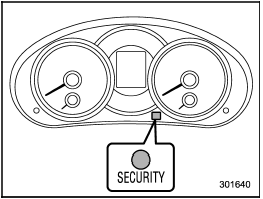
Type A
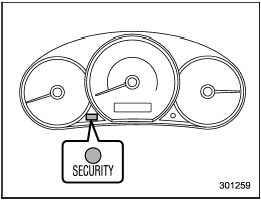
Type B
The security indicator light deters potential thieves by indicating that the vehicle is equipped with an immobilizer system. It begins flashing in the following ways.
- Once approximately every 3 seconds:
– Approximately 60 seconds after the
ignition switch is turned from the “ON”
position to the “Acc” or “LOCK” position
– Immediately after the ignition key is
pulled out
- Twice approximately every 2 seconds:
After the alarm system has been armed for surveillance (Refer to “Arming the system”.)
- Five times approximately every 2 seconds:
When the alarm system is ready to be armed.
- Other flashing patterns:
The alarm system may have been triggered by unauthorized intrusion or any impact to the vehicle body. Refer to “Tripped sensor identification”.
If the security indicator light does not flash, the immobilizer system may not be functioning properly. If this occurs, contact your SUBARU dealer as soon as possible.
In case an unauthorized key is used (e.g., an imitation key), the security indicator light illuminates.
NOTE
Even if the security indicator light
flashes irregularly or its fuse blows
(the light does not flash if its fuse is
blown), the immobilizer system will
function normally.
SPORT mode indicator light (AT models)

When the select lever is moved to the manual gate, the SPORT mode is selected and the indicator light illuminates.
Refer to “SPORT mode”.
Select lever and gear position indicator (AT models)
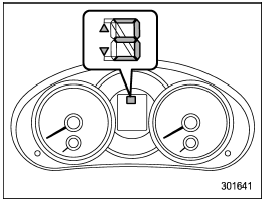
Type A
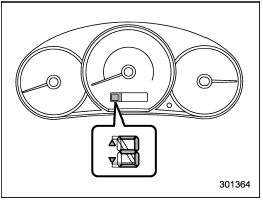
Type B
This indicator shows the position of the select lever.
When the manual mode is selected, the gear position indicator (which shows the current gear selection) and the upshift/ downshift indicator light up. Refer to “Automatic transmission”.
Turn signal indicator lights

These lights show the operation of the turn signal or lane change signal.
If the indicator lights do not blink or blink rapidly, the turn signal bulb may be burned out. Replace the bulb as soon as possible.
Refer to “Replacing bulbs”.
High beam indicator light

This light shows that the headlights are in the high beam mode.
This indicator light also illuminates when the headlight flasher is operated.
Cruise control indicator light

This light illuminates when the “CRUISE” main switch is pressed.
If you press the main switch button while turning the ignition switch “ON”, the cruise control function is deactivated and the “CRUISE” indicator light flashes. To reactivate the cruise control function, turn the ignition switch back to the “Acc” or “LOCK” position, and then turn it again to the “ON” position.
Cruise control set indicator light

This light illuminates when vehicle speed has been set.
Front fog light indicator light (if equipped)

This indicator light is on while the front fog lights are on.
Headlight indicator light

This indicator light illuminates when the
headlight switch is placed in the “ ”
or
“
”
or
“ ” position.
” position.
Clock
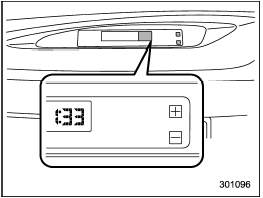
Clock
The clock shows the time while the ignition switch is in the “Acc” or “ON” position.
The time changes by 1 minute each time the “+” button or “−” button is pressed.
Pressing the “+” button moves the displayed time forward, while pressing the “−” button moves the displayed time back.
Pressing and holding either button changes the displayed time continuously.

To ensure safety, do not attempt to set the time while driving, as an accident from inadequate attention to the road could result.
NOTE
If the battery is disconnected, the time
will be erased. After reconnecting the
battery, set the correct time.
See also:
Accessory power outlets
Power outlet below the climate controls
Power outlet in the center console
Power outlet in the cargo area
Accessory power outlets are provided
below the climate controls, in the center
console and in the cargo area. Electrical
po ...
Maintenance Procedures
The pages that follow contain the required maintenance
services determined by the engineers who designed your
vehicle.
Besides those maintenance items specified in the fixed
maintenance schedule, there are other components which
may require ...

 Meters and gauges
Meters and gauges